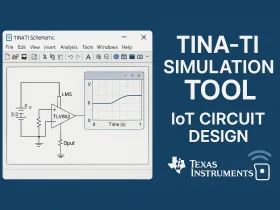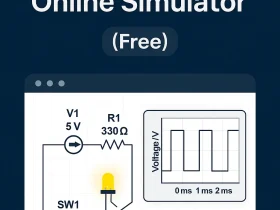What is Beacon technology?
Beacons are usually small standalone devices that are attached to walls or objects in the environment. The simplest beacons simply send out a signal to devices in range but they may also be Wi-Fi– and cloud-connected and can contain memory, processing resources and sensors for temperature and motion detection (among other possibilities).
Understanding Beacons, their types and applications
![]()
A typical configuration might include an ARM processor, a Nordic Semiconductor or Texas Instruments chipset, a Bluetooth Low Energy (BLE) module, and a battery. The devices are low-power and inexpensive, with a battery life of several years.
Beacons are often said to work like lighthouses, sending out an intermittent signal that can be detected by an entity within range. Instead of the light signals that guide ships, however, the beacon emits a radio signal that can be picked up by nearby mobile devices equipped with the associated app.
Vehicular beacons are rotating or flashing lights affixed to the top of a vehicle to attract the attention of surrounding vehicles and pedestrians.
Emergency vehicles such as fire engines, ambulances, police cars, tow trucks, construction vehicles, and snow-removal vehicles carry beacon lights.
The color of the lamps varies by jurisdiction; typical colors are blue and/or red for police, fire, and medical-emergency vehicles; amber for hazards (slow-moving vehicles, wide loads, tow trucks, security personnel, construction vehicles, etc.); green for volunteer firefighters or for medical personnel, and violet for funerary vehicles.
Beacons may be constructed with halogen bulbs similar to those used in vehicle headlamps, xenon flash tubes, or LEDs
Google’s Eddystone and Apple’s iBeacon are the two most commonly implemented beacon protocols.
Any hardware device that supports Bluetooth 4.0 can, in theory, become a beacon in an iBeacon network, which means that smartphones, PCs, and tablets can function as beacons.
The beacon continuously scans for iOS-based mobile devices that have Bluetooth open and are running the associated mobile app. When the beacon detects such a device, it sends a connection request to wake up the app.
Information within the request includes the information required to push the desired communication to the device in real time.
There are many advantages to Google’s Eddystone. Firstly, it can send out a URL, which removes the necessity of the installed app and Telemetry information.
It even has an open format which makes it flexible to use. It is also integrated with various Google products which add on to its diverse use.
Beacons are increasingly implemented in retail environments, where they are used to streamline mobile payment systems and enable proximity marketing: the wireless delivery of promotional material to mobile users within range.
The location may be so precise that the communications target a shopper standing in front of a particular product with coupon offers, flash sales and suggestions for related products — among many other possibilities.
Beacons technology has many other applications. The same precision of targeting that finds consumers can enable communications directed to someone in a particular seat at a stadium or standing in front of a museum installation or an artwork in a gallery.
The technology can provide users with directions or maps to airport locations such as gates, ticket counters, shops, and restaurants, as well as identifying the closest elevators, restrooms, and courtesy phones. Similar apps can help guide people in other large facilities, such as hospitals and help them find their cars when they leave those locations.
AltBeacon is also another type of Beacon. It is mostly a radius network and was announced in 2014. This was designed to overcome the issue of protocols favoring one vendor over the other. Unlike other Beacons, this one is open-source.
It has compatibility with other mobile operating platforms. It is even more flexible with customizable source code.
In addition to tracking objects themselves, beacons could be used to track people such as patients or doctors in hospitals during emergencies. The focus may have initially been on the retail industry, but as the technology matures, we can expect other sectors to follow in understanding how beacons technology can aid their day-to-day activities.
Beacons help guide navigators to their destinations. Types of navigational beacons include radar reflectors, radio beacons, sonic and visual signals.
Visual beacons range from small, single-pile structures to large lighthouses or light stations and can be located on land or on water. Lighted beacons are called lights; unlighted beacons are called day beacons.
Aerodrome beacons are used to indicate locations of airports and helipads. Handheld beacons are also employed in aircraft marshaling and are used by the marshal to deliver instructions to the crew of aircraft as they move around an active airport, heliport or aircraft carrier.
See also: Smart Retail; IoT in Retail Industry for Smart experience
Understanding of Beacon Technology working
![]()
Beacon technology is one of the new technological advancements which have been made in the 21st Century.
In a series of shorter spam, the Beacon technology has been gaining massive popularity. It is used in almost every aspect of human life.
A beacon, in the context of location-based services, is a small hardware device that enables data transmission to mobile devices within a specific range of the device.
Beacons are often said to work like lighthouses, sending out an intermittent signal that can be detected by an entity within range. Beacons are small computers, roughly the size of a standard Wi-Fi router.
As part of indoor positioning systems, beacons use proximity technology to detect human presence nearby and trigger pre-set actions to deliver informational, contextual, and personalized experiences.
The beacon device itself is incredibly simple. Each device contains a CPU, radio, and batteries, and it works by repeatedly broadcasting out an identifier. This identifier is picked up by your device, usually mobile, and marks out an important place in your environment.
The identifier is a unique ID number that your smartphone recognizes as unique to the beacon. Once connected, the beacon will carry out whatever function it has been programmed to perform.
We will go into more detail later on some of the many functions beacons can carry out.
In the beacon industry, such a mobile app is regarded as an iBeacon app, an Eddystone app, or an indoor navigation app.
Put simply, it’s a mobile application that supports beacon technology and is installed on a mobile operating system supporting one of the beacon standards.
Apple smartphones with iOS 7 and higher support the iBeacon standard, smartphones on Android 4 and up use the Eddystone standard. Hence the Eddystone and iBeacon app; “indoor navigation app” is just a more general term.
Beacon is actually a minicomputer having the size of the Wi-Fi router.
It is an indoor positioning system which makes use of proximity tech for fetching the presence of the human around and do the already set actions to bring out the contextual, informational, and personalized experiences.
When the user walks around the area where this indoor positioning system is set, the beacon will send the code to the mobile device of the user through a text message. Well, this message can only be sent in the form of push notification through the mobile app.
Users receive coded messages from beacons via Bluetooth Low Energy (BLE) — a power-efficient Bluetooth technology developed for the Internet of Things applications and devices. Moreover, an app doesn’t even have to be running to be awakened by the beacon signal.
![]()
On the latter: one of the major differences between beacons and RFID (radio-frequency identification) is that beacon technology allows for more private user experience, as it works only if paired with a mobile app — users stay in complete control and have the option of opting out.
Apple explains iBeacon technology to consumers as the enabling technology for Apple devices to alert apps or websites (which the user has opted into) when someone approaches or leaves a location.
In other words, retail or other venues that have beacons in place can detect where a customer is at any given moment. Then — and this is the key part, of course — the retailer or other business can push timely messages to that customer promoting products or providing other useful information.
Say someone is walking past a retail store; if they’ve downloaded the retailer’s mobile app, the company can use beacon messages to capture their attention as they go by, enticing them to enter. Once inside, beacons can be used to make personalized offers, speed checkout processes and pretty much anything else the retailer can dream up.
Beacons began as devices about the circumference of a large apple; today they’re mere stickers that can be placed on walls or objects.
The smaller and less obtrusive they get, the easier they become to use. Beacons employ Bluetooth low-energy (BLE) wireless technology to pinpoint the location of customers in stores and other places and to deliver messages to their mobile devices.
Specifically, a beacon emits a BLE signal that a retailer’s or other company’s app on a smartphone coming within range of that signal can pick up on.
A big differentiation between beacons and RFID is that beacons are far more private because it gives users control of the apps that leverage the beacon. This also generally means that beacons are authenticated and with user permission, which can ultimately lead to tremendous experiences as a result.
It is difficult to say how popular beacon technology will become; the technology is still relatively fresh off the block and has had its fair share of setbacks.
Upon their release, there was a lot of hype and plenty of promise, yet beacons did not take off as many expected.
However, with Google’s recent plans to make the platform-agnostic and easier for developers to program, we can expect more companies to adopt the technology.
One enormous advantage beacon have is that they are relatively inexpensive in comparison to other technologies, so businesses large and small can adopt the technology with very little risk.
See also: How to Use IoT Device Over Internet: A Beginner’s Guide
See also: MQTT Protocol in IoT: What It Is, How It Works, and Key Applications
Let us know what you think about” Beacon technology working” in the comment section below.
Start Your IoT Journey Today
🔔 Subscribe to Our YouTube Channel » for IoT video Tutorials.
🌐 Start Learning IoT Basics Now » and What is IoT? – Introduction to IoT for Beginners on IoTDunia.com!
Check out Top IoT Applications in Real World – Smart Use Cases 2025, IoT career guide 2025, Best Projects on IoT for Beginners









Leave a Review